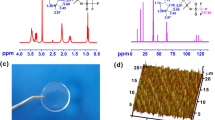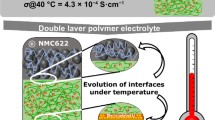Abstract
Despite the high-energy densities, the safety problem of thermal runaway in lithium-ion batteries (LIBs) severely hinders their further application. Therefore, as an essential part of LIBs, the separator should ideally have good thermal stability at high temperatures. Here, a novel polyrotaxane (PR)-based gel polymer electrolyte (GPE) with good thermal stability is made by a simple solution casting method. The thermal shrinkage of the PR is less than 20% even heated at 200 °C; in contrast, the commercial Celgard 2400 separator undergoes dramatic deformation above 140 °C. The gel polymer electrolyte presents excellent compatibility in the cells of LiFePO4 and LiNi0.5Co0.2Mn0.3O2 cathode. The cell composed of Li/GPE/LiFePO4 presents good discharge performance and excellent stored performance. The cell composed of Li/GPE/LiNi0.5Mn0.3Co0.2O2 presents excellent capacity retention of 85.9% in 300 cycles while discharging at the 0.5 C rate. This GPE is promising to be applied to Li metal batteries with high safety and good cycle life.






Similar content being viewed by others
References
Lu J, Chen Z, Pan F, Cui Y, Amine K (2018) High-performance anode materials for rechargeable lithium-ion batteries. Electrochem Energy Rev 1:35–53. https://doi.org/10.1007/s41918-018-0001-4
Xiang J, Yang L, Yuan L, Yuan K, Zhang Y, Huang Y, Lin J, Pan F, Huang Y (2019) Alkali-metal anodes: from lab to market. Joule 3:2334–2363. https://doi.org/10.1016/j.joule.2019.07.027
Tarascon JM, Armand M (2001) Issues and challenges facing rechargeable lithium batteries. Nature 414:359–367. https://doi.org/10.1038/35104644
Ma S, Lin H, Yang L, Tong Q, Pan F, Weng J, Zheng S (2019) High thermal stability and low impedance polypropylene separator coated with aluminum phosphate. Electrochim Acta 320:134528. https://doi.org/10.1016/j.electacta.2019.07.039
Song Y, Yang L, Zhao W, Wang Z, Zhao Y, Wang Z, Zhao Q, Liu H, Pan F (2019) Solid-state electrolytes: revealing the short-circuiting mechanism of garnet-based solid-state electrolyte. Adv Energy Mater 9:1970076. https://doi.org/10.1002/aenm.201900671
Wang K, Yang L, Wang Z, Zhao Y, Wang Z, Han L, Song Y, Pan F (2018) Enhanced lithium dendrite suppressing capability enabled by a solid-like electrolyte with different-sized nanoparticles. Chem Commun 54:13060–13063. https://doi.org/10.1039/c8cc07476c
Wang Z, Wang Z, Yang WH, Song Y, Han L, Yang K, Hu J, Chen H, Pan F (2018) Boosting interfacial Li+ transport with a MOF-based ionic conductor for solid-state batteries. Nano Energy 49:580–587. https://doi.org/10.1016/j.nanoen.2018.04.076
Yang L, Wang Z, Feng Y, Tan R, Zuo Y, Gao R, Zhao Y, Han L, Wang Z, Pan F (2017) Flexible composite solid electrolyte facilitating highly stable “soft contacting” Li-electrolyte interface for solid state lithium-ion batteries. Adv Energy Mater 7:1701437. https://doi.org/10.1002/aenm.201701437
Jaumaux P, Liu Q, Zhou D, Xu X, Wang G (2020) Deep eutectic solvent-based self-healing polymer electrolyte for safe and long-life lithium metal batteries. Angew Chem Int Ed 59:9134–9142. https://doi.org/10.1002/anie.202001793
Gong S, Huang Y, Cao H, Lin Y, Li Y, Tang S, Wang M, Li X (2016) A green and environment-friendly gel polymer electrolyte with higher performances based on the natural matrix of lignin. J Power Sources 307:624–633. https://doi.org/10.1016/j.jpowsour.2016.01.030
Wu J, Wang X, Liu Q, Wang S, Zhou D, Kang F (2021) A synergistic exploitation to produce high-voltage quasi-solid-state lithium metal batteries. Nat Commun 12:5746. https://doi.org/10.1038/s41467-021-26073-6
Ren W, Ding C, Fu X, Huang Y (2021) Advanced gel polymer electrolytes for safe and durable lithium metal batteries: challenges, strategies, and perspectives. Energy Stor Mater 34:515–535. https://doi.org/10.1016/j.ensm.2020.10.018
Zhou D, Shanmukaraj D, Tkacheva A, Armand M, Wang G (2019) Polymer electrolytes for lithium-based batteries: advances and prospects. Chem 5:2326–2352. https://doi.org/10.1016/j.chempr.2019.05.009
Zhu M, Wu J, Wang Y, Song M, Long L, Siyal SH, Yang X, Sui G (2019) Recent advances in gel polymer electrolyte for high-performance lithium batteries. J Energy Chem 37:126–142. https://doi.org/10.1016/j.jechem.2018.12.013
Song JY, Wang YY, Wan CC (1999) Review of gel-type polymer electrolytes for lithium-ion batteries. J Power Sources 77:183–197. https://doi.org/10.1016/s0378-7753(98)00193-1
Zhu L, Li J, Jia Y, Zhu P, Jing M, Yao S, Shen X, Li S, Tu F (2020) Toward high performance solid-state lithium-ion battery with a promising PEO/PPC blend solid polymer electrolyte. Int J Energy Res 44(13):10168–10178. https://doi.org/10.1002/er.5632
Xue Z, Xie D, He X (2015) Poly(ethylene oxide)-based electrolytes for lithium-ion batteries. J Mater Chem A3:19218–19253. https://doi.org/10.1039/c5ta03471j
Hu P, Chai J, Duan Y, Liu Z, Cui G, Chen L (2016) Progress in nitrile-based polymer electrolytes for high performance lithium batteries. J Mater Chem A4:10070–10083. https://doi.org/10.1039/c6ta02907h
Zhang H, Zhang J, Ma J, Xu G, Dong T, Cui G (2019) Polymer electrolytes for high energy density ternary cathode material-based lithium batteries. Electrochem Energy Rev 2:128–148. https://doi.org/10.1007/s41918-018-00027-x
Waqas M, Ali S, Feng C, Chen D, Han J, He W (2019) Recent development in separators for high-temperature lithium-ion batteries. Small 15:1901689. https://doi.org/10.1002/smll.201901689
Ali S, Tan C, Waqas M, Lv W, Wei Z, Wu S, Boateng B, Liu J, Ahmed J, Xiong J, Goodenough JB, He W (2018) Highly efficient PVDF-HFP/colloidal alumina composite separator for high-temperature lithium-ion batteries. Adv Mater Inter 5:1701147. https://doi.org/10.1002/admi.201701147
Liu Y, Qiao Y, Zhang Y, Yang Z, Gao T, Kirsch D, Liu B, Song J, Yang B, Hu L (2018) 3D printed separator for the thermal management of high-performance Li metal anodes. Energy Stor Mater 12:197–203. https://doi.org/10.1016/j.ensm.2017.12.019
Long L, Wang S, Xiao M, Meng Y (2016) Polymer electrolytes for lithium polymer batteries. J Mater Chem A 4:10038–10069. https://doi.org/10.1039/c6ta02621d
Harada A, Okada M, Kawaguchi Y, Kamachi M (1999) Macromolecular recognition: new cyclodextrin polyrotaxanes and molecular tubes. Polym Adv Technol 10:3–12. https://doi.org/10.1002/(sici)1099-1581(199901/02)10:1/2%3c3::aid-pat759%3e3.0.co;2-s
Harada A, Li J, Kamachi M, Kitagawa Y, Katsube Y (1997) Structures of polyrotaxane models. Carbohydr Res 305:127–129. https://doi.org/10.1016/s0008-6215(97)00276-0
Choi S, Kwon TW, Coskun A, Choi JW (2017) Highly elastic binders integrating polyrotaxanes for silicon microparticle anodes in lithium-ion batteries. Science 357:279–283. https://doi.org/10.1126/science.aal4373
Imholt L, Dörr TS, Zhang P, Ibing L, Cekic-Laskovic I, Winter M, Brunklaus G (2019) Grafted polyrotaxanes as highly conductive electrolytes for lithium metal batteries. J Power Sources 409:148–158. https://doi.org/10.1016/j.jpowsour.2018.08.077
Chen G, Xu Y, Shi T, Wu X (2019) Preparation and properties of polyacrylonitrile/polyethylene glycol composite fibers phase change materials by centrifugal spinning. Mater Res Express 6:095502. https://doi.org/10.1088/2053-1591/ab2d0a
Dognani G, Hadi P, Ma H, Cabrera FC, Job AE, Agostini DLS, Hsiao BS (2019) Effective chromium removal from water by polyaniline-coated electrospun adsorbent membrane. Chem Eng J 372:341–351. https://doi.org/10.1016/j.cej.2019.04.154
Senra JD, Malta LFB, Costa MEHM, Michel RC, Aguiar LCS, Simas ABC, Antunes OAC (2009) Hydroxypropyl-α-cyclodextrin-capped palladium nanoparticles: active scaffolds for efficient carbon-carbon bond forming cross-couplings in water. Adv Synth Catal 351(14–15):2411–2422. https://doi.org/10.1002/adsc.200900348
Harada A, Kamachi M (1990) Complex formation between poly(ethylene glycol) and ɑ-cyclodextrin. Macromolecules 23(10):2821–2823. https://doi.org/10.1021/ma00212a039
Lin Y, Ito K, Yokoyama H (2018) Solid polymer electrolyte based on crosslinked polyrotaxane. Polymer 136:121–127. https://doi.org/10.1016/j.polymer.2017.12.046
Hu Z, Chen J, Guo Y, Zhu J, Qu X, Niu W, Liu X (2020) Fire-resistant, high-performance gel polymer electrolytes derived from poly(ionic liquid)/P(VDF-HFP) composite membranes for lithium ion batteries. J Membr Sci 599:117827. https://doi.org/10.1016/j.memsci.2020.117827
Ahn JH, You T, Lee S, Esken D, Dehe D, Huang Y, Kim D (2020) Hybrid separator containing reactive, nanostructured alumina promoting in-situ gel electrolyte formation for lithium-ion batteries with good cycling stability and enhanced safety. J Power Sources 472:228519. https://doi.org/10.1016/j.jpowsour.2020.228519
Zhang Q, Liu Y, Ma J, Zhang M, Ma X, Chen F (2019) Preparation and characterization of polypropylene supported electrospun POSS-(C3H6Cl)8/PVDF gel polymer electrolytes for lithium-ion batteries. Colloids Surf A 580:123750. https://doi.org/10.1016/j.colsurfa.2019.123750
Forbey SJ, Divoux GM, Moore KE, Moore RB (2015) Cross-linked electrospun poly(ethylene oxide) fiber mats as structured polymer-gel electrolyte. ECS Trans 66(35):1–15. https://doi.org/10.1149/06635.0001ecst
Fan Z, Ding B, Zhang T, Lin Q, Malgras V, Wang J, Dou H, Zhang X, Yamauchi Y (2019) Solid/solid interfacial architecturing of solid polymer electrolyte-based all-solid-state lithium-sulfur batteries by atomic layer deposition. Small 15(46):1903952. https://doi.org/10.1002/smll.201903952
Yu J, He Y, Zou S, Na B, Liu H, Liu J, Li H (2020) Redox-active manganese dioxide@polypropylene hybrid separators for advanced lithium ion batteries. Appl Surf Sci 508:144757. https://doi.org/10.1016/j.apsusc.2019.144757
Liu B, Huang Y, Cao H, Zhao L, Huang Y, Song A, Lin Y, Li X, Wang M (2018) A novel porous gel polymer electrolyte based on poly(acrylonitrile-polyhedral oligomeric silsesquioxane) with high performances for lithium-ion batteries. J Membr Sci 545:140–149. https://doi.org/10.1016/j.memsci.2017.09.077
Liu B, Huang Y, Zhao L, Huang Y, Song A, Lin Y, Wang M, Li X, Cao H (2018) A novel non-woven fabric supported gel polymer electrolyte based on poly(methylmethacrylate-polyhedral oligomeric silsesquioxane) by phase inversion method for lithium ion batteries. J Membr Sci 564:62–72. https://doi.org/10.1016/j.memsci.2018.07.014
Guan X, Wu Q, Zhang X, Guo X, Li C, Xu J (2020) In-situ crosslinked single ion gel polymer electrolyte with superior performances for lithium metal batteries. Chem Eng J 382:122935. https://doi.org/10.1016/j.cej.2019.122935
Fu X, Shang C, Yang M, Akinoglu EM, Wang X, Zhou G (2020) An ion-conductive separator for high safety Li metal batteries. J Power Sources 475:228687. https://doi.org/10.1016/j.jpowsour.2020.228687
Chai J, Liu Z, Ma J, Wang J, Liu X, Liu H, Zhang J, Cui G, Chen L (2017) In situ generation of poly (vinylene carbonate) based solid electrolyte with interfacial stability for LiCoO2 lithium batteries. Adv Sci 4(2):1600377. https://doi.org/10.1002/advs.201600377
Song A, Huang Y, Zhong X, Cao H, Liu B, Lin Y, Wang M, Li X (2017) Gel polymer electrolyte with high performances based on pure natural polymer matrix of potato starch composite lignocellulose. Electrochim Acta 245:981–992. https://doi.org/10.1016/j.electacta.2017.05.176
Jie J, Liu Y, Cong L, Zhang B, Lu W, Zhang X, Liu J, Xie H, Sun L (2020) High-performance PVDF-HFP based gel polymer electrolyte with a safe solvent in Li metal polymer battery. J Energ Chem 49:80–88. https://doi.org/10.1016/j.jechem.2020.01.019
Gao H, Huang Y, Zhang Z, Huang J, Li C, (2020) Li6.7La3Zr1.7Ta0.15Nb0.15O12 enhanced UV-cured poly(ethylene oxide)-based composite gel polymer electrolytes for lithium metal batteries. Electrochim Acta 360:137014 https://doi.org/10.1016/j.electacta.2020.137014
Wang C, Gong Y, Liu B, Fu K, Yao Y, Hitz E, Li Y, Dai J, Xu S, Luo W, Wachsman ED, Hu L (2017) Conformal, nanoscale ZnO surface modification of garnet-based solid-state electrolyte for lithium metal anodes. Nano Lett 17(1):565–571. https://doi.org/10.1021/acs.nanolett.6b04695
Xie Z, Wu Z, An X, Yoshida A, Wang Z, Hao X, Abudula A, Guan G (2019) Bifunctional ionic liquid and conducting ceramic co-assisted solid polymer electrolyte membrane for quasi-solid-state lithium metal batteries. J Membr Sci 586:122–129. https://doi.org/10.1016/j.memsci.2019.05.066
Yang X, Jiang M, Gao X, Bao D, Sun Q, Holmes N, Duan H, Mukherjee S, Adair K, Zhao C, Liang J, Li W, Li J, Liu Y, Huang H, Zhang L, Lu S, Lu Q, Li R, Singh CV, Sun X (2020) Determining the limiting factor of the electrochemical stability window for PEO-based solid polymer electrolytes: main chain or terminal -OH group? Energy Environ Sci 13:1318–1325. https://doi.org/10.1039/d0ee00342e
Funding
This work was supported by the Fujian Provincial Science and Technology Department’s University Industry Cooperation Project (grant nos. 2016H6006, 2020H6010) and Fuzhou Science and Technology Bureau Project (grant no. 2017-G-68).
Author information
Authors and Affiliations
Corresponding author
Additional information
Publisher's note
Springer Nature remains neutral with regard to jurisdictional claims in published maps and institutional affiliations.
Rights and permissions
About this article
Cite this article
Li, J., Wang, Z., Tong, Q. et al. Polyrotaxane-based electrolyte with excellent thermal stability for quasi-solid lithium metal batteries. Ionics 28, 3623–3634 (2022). https://doi.org/10.1007/s11581-022-04610-7
Received:
Revised:
Accepted:
Published:
Issue Date:
DOI: https://doi.org/10.1007/s11581-022-04610-7




